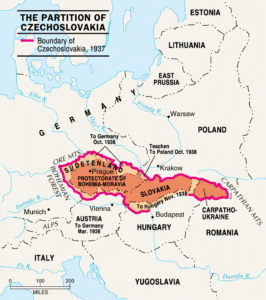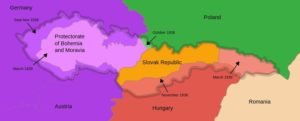Historical Paper-The Partition of Czechoslovakia: Economic Factors
A Historical Paper
Introduction
War 1 has its huge effects towards Europe, for after the war some nation or countries were created such as Czechoslovakia, Yugoslavia, Estonia, Latvia, Finland, and many more after signing the Treaty of Versailles. The Czechoslovakia was compose of two different states, the Czech and Slovak. These two states are different in terms of nationality, culture, economic, social, and politics. And despite of these differences it didn’t stop them to form an alliance and seek for independent towards their masters. The Czech was subjected by the Austrian while the Slovak was subjected by the Hungarian, and these two states has finally gained their independents and then after that they become one country on 1918 in the name of Czechoslovakia Republic. On January 1, 1993 the Czechoslovakia Republic split, some would claim that it was because of political, economic and social factors that led to the separation. And this essay would focus more on its economic factors, because some literature account about the Separation of Czechoslovakia focus on its political factors.

Source
The key to understand the reason why separation occurred can be found predominantly in the Historical approach. Although these two states has many differences but they do have the same ancestors. It was to believe that that their ancestor was the Bohemia and Moravia, these two states were both belong to the family of Slavs. The culture of both Czech and Slovak remained closed but their their economic and political development was influenced by western Europe. On 1526 both the Czech and Slovak were under the rule of the Hapsburg Empire but they followed different path of development. On 1867, it was the establishment of the dual monarchy, the Austria-Hungary empire and as a result of this, the Czech were subjected to Austria while Slovak were subjected to Hungary. Austria and Hungary is different in terms of political system. The Austria was Parliamentary and because of that the Czech people will given a chance to have greater and greater position under the rule of Austrian, while in the case of Slovak under the rule of Hungary they were pretty much controlled by the Hungarian aristocracy, and because of this few of the Slovakian were given a position under the rule of Hungarian.
Analysis of Points According to Gwadiak (1987) At the end of 19 century the contacts between the Czech and Slovak intensified. Both of the the leaders of Czech and Slovak were advocated of “Czechoslovakia” entity. These Czech and Slovak nationalism movements began drawing closer together, but their ultimate goals remained unclear. Not until the World War 1 in which both of these two states struggled for autonomy against their masters. And according to Gwadiak only during the war did the Idea of an independent Czechoslovakia emerge. Masaryk went to western Europe and began promulgating the idea of the Austria-Hungary Empire should be dismembered and the Czechoslovakia should be an independent state. And after the long process of negotiation on October 18, 1918 the Czech and Slovak has given their own independent.
After the alliances of the two states they began creating their own policies. But dissatisfaction emerged between these two states. Since the Czech was dominated by the Austrian, and under the Austrian they experienced such as political, economy and religious autonomy and on 19 century Czech was already highly industrialized . While In the case of Slovak they didn’t have attain of high level of political, economic and cultural development. Well, it can be trace by their masters, Austria is far more enlightened than the Hungarian. The Slovak community appeal to have an autonomy but the Czechoslovakian Government didn’t agree on this, because according to the Slovakian the newly founded nation didn’t installed some program that could help to the development of Slovak. So tension rise between the two states.
On 1939, Slovak created their own state under the Protectorate of the Nazi-state and for the Czechs it is a kind of betrayal. During the Second World War, the Germans invaded Czechoslovakia. And after the War, Czechoslovakia fell to the hands of Soviet Union and the Slovak was included to Czechoslovakia again. Communism was established in Czechoslovakia on 1949, and during the Era of Communism the Czechs were paying huge amount for the Development of Slovakia. And yes the Economy of Slovak during this time increased into five times, since the Communist party promised that they will try to eradicate the Economic gap between Czech and Slovak. And Blazek (2000) argued that the economic rate of the two states was almost the same on 1980’s.
Unbalance Economy: The Disparity between Czech and Slovak
Economic disparity between Czech and Slovak has one of its factors why separation occurred. Since the early 19 century Czech was already industrialized state because the Czech was part of the most developed part of the Austrian side while Slovak was still un-modernized state, because the Slovak part was the poorest part of the Hungarian side. Czech was traditionally concentrated around heavy industry and coal mining while the Slovak was traditionally concentrated in agricultural state. And when Czechoslovakia was founded on 1918 Slovak begun to developed their industry as they got help from their partners he Czech, from agricultural state to an industrial state. And during the communist period the Slovak Republic was highly industrialized, but only in the way that they produced raw material because the processing of raw materials to a finished product was in Czech Republic. After the Second World War there were major changes in Czechoslovakia as it change to communism. Their economy changed from market economy to planned economy. The agricultural sector was reorganized, the economy was governed by five year plans. Heavy industry led to a strong demand for raw materials. The first five year plans expand the producer good sector of the economy, the country become an important supplier of of machinery and arms to other communist country, but foreign trade with non communist countries dropped immediately. Though investment and growth were high, the economy of Czechoslovakia failed to reach their goals of the first plan.
The Start of Disintegration
The turning point between Czech and Slovak arose when Federation established in Czechoslovakia on 1969, the main reason of this reform was the Slovak autonomy, this institutional reform was designed to end Slovak fear of Czech domination of the legislative branch of the government. Nationalism between the two states arose as for the Czech they believed that the Slovak is an economic burden, this kind of nationalism was based on the belief that the Czechs are more advanced and urbanized. Both Czech and Slovak has its own grievances to each other, Some Czechs would thought that they are putting their money into some poor land in Slovak and at the same time Slovak cried that their economy and industry is crippled by decisions of central government in Prague.
Aside from that, the leaders of Czech perceived that the Slovak as a weak partner and it would slow down the Czech engine of growth. Some historian elaborated the differences of the two countries economy, Slovak was an agrarian country while Czech was in manufacturing, constructions, and crafts. During the debate of the two states they focus about the differences not on the similarity performance which led to conflict. The Czech and Slovak leaders both know that Slovak economy to be the weaker performance in the future.
On January 1993, Czechoslovakia experienced a two step break up. On January 1, Czechoslovakia only disintegrated as a political union preserving an economic and monetary union, but on February 8, Czech and Slovak monetary union eventually collapsed. From the perspective of Optimum Currency Area Theory this will give us deep economic analyzation why separation occurred. According to Maschlup (1997) Optimum Currency Area is a region no part of which insist on creating money and having monetary on its own. The low correlation of permanent shocks in the pre-reform period constituted a source of instability and pressure for exchange rate adjustments in the presence of a large asymmetric shock. After the collapsed of communism on 1989 because of the Velvet revolution brought about substantial asymmetric development as evidenced by the large differences in unemployment rates. Labor mobility mobility proved ineffective in mitigating these adverse effects. Fiscal transfers were insufficient to equilibrate the shocks and became increasingly politically costly over time. The asymmetric economic developments in turn engendered deepening political differences between the two republics (Jan Fidrmurc, 1999).
Conclusion
If the separation of Czechoslovakia was only caused by political factors, then why abandoning the common currency. So it implies here that there is really economic factors why separation occurred. The fact that a common currency did not last for more than one month suggest that there may have been deeper economic reasons for the separation. Some intellectuals may have been concluded that it was the political factors that led to the separation of Czechoslovakia and the Economic factors only caused minor roles to the separation.But it is undeniable that Economic factors also played a major roles to the separation. Analyzing their historical background and economic background would gives a credible account why the separation occurred. And also the separation of Czechoslovakia are example of economic tension that undermined the political unity and monetary unity. Fortunately, the separation did not caused a trouble even though the separation is not based on referendum or not participated by the majority of the people rather it was only participated by the politicians, the divorce was peaceful and quick and according to my research they are good neighbors to these days.
Books
Innes, Abiguel. The Partition of Cezechoslovakia. Ph.D Thesis, London School of Economic and Political Science.
Gwadiak, Lhor. (1987). A country Czechoslovakia. For sale by the Superintendent of Documents, U.S. Government Printing Office Washington, D.C. 20402
Stolarik, M. (2016). The Czech and Slovak Republic: Twenty Years of Independence, 1993-2013. Central European University Press Budapest-University
Rubeskova et al. (2013). Two Decades on from the Breakup of Czechoslovakia: Departures, Diversions, and Destinations. CEPS COMMENTARY
Kraus, M. Stanger, A. (2000). Irreconcilable Differences?: Explaining Czechoslovakia’s. Rowman and littlefield Publisher.
Gobernko, A. Strebulaev, I. (2009). temporary Versus Permanent Shocks:Explaining Corporate Financial Policies.
Patterson, B. Amati, S. (1998). Adjustment to Asymmetric Shocks. European Parliament L-2929 Luxembourg. Economic Affairs Series
Journals
Blazek, J. (2012). Break Up of Czechoslovakia: Roots, 1989, and Consequences. Universitat Charles, Praga
Fidmurc et al. (1999). The Stability of Monetary Unions: Lessons from the Breakup of Czechoslovakia
Posted from my blog with SteemPress : http://zam398.vornix.blog/2018/07/22/historical-paper-the-partition-of-czechoslovakia-economic-factors/


